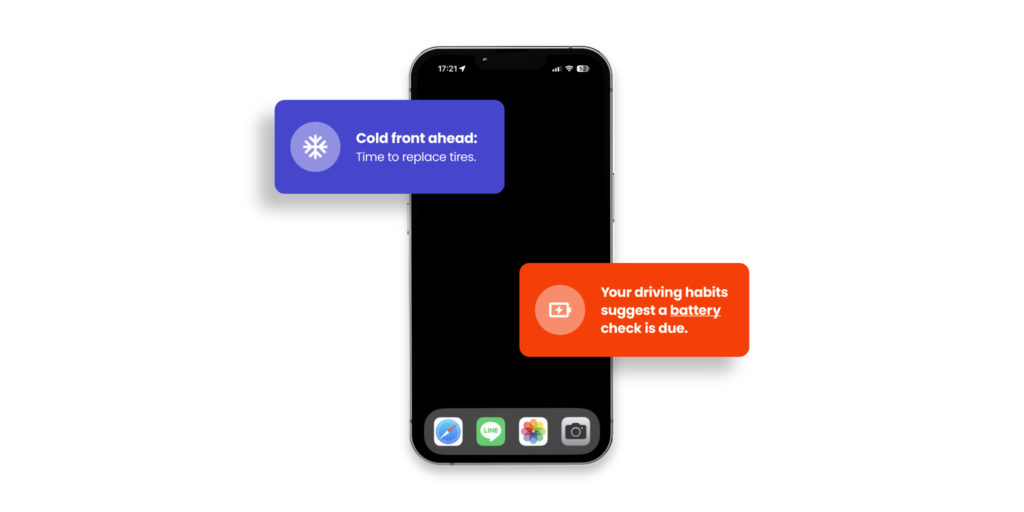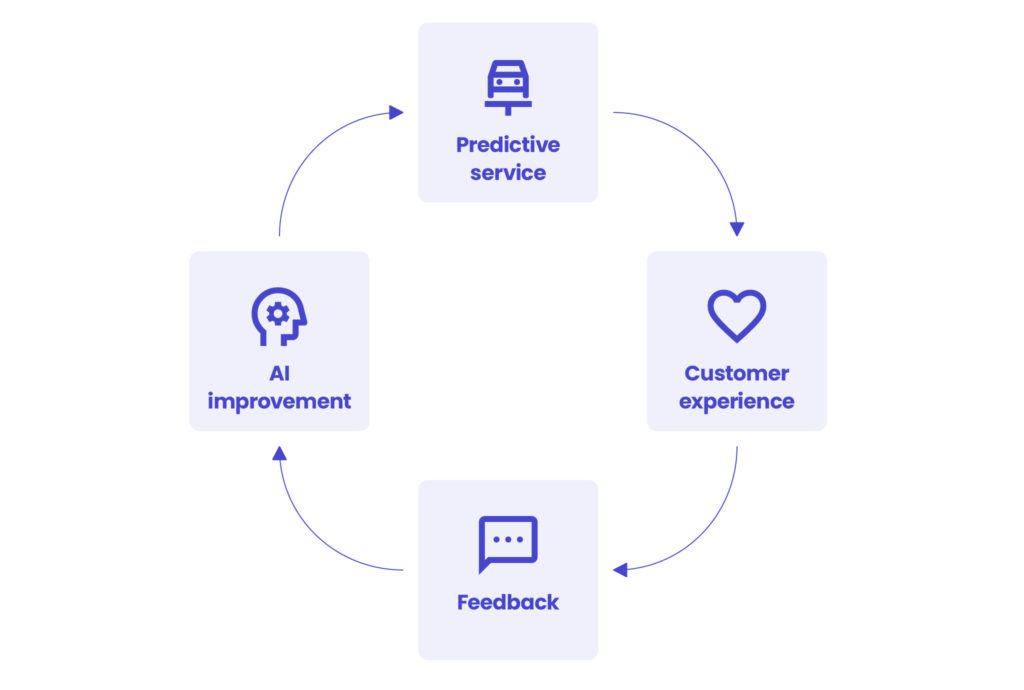Client loyalty and predictive maintenance: a new approach to customer retention
In an automotive industry driven by innovative engineering and operational precision, customer retention may often slip into the background. However, in today’s competitive world, client loyalty is the key factor that can propel your growth strategy.
In this article, you’ll discover how predictive maintenance software and historical data transform everyday interactions into long-term customer loyalty.
Customer loyalty beyond discounts
Client loyalty is no longer acquired through points programmes or discounts alone.
True loyalty is earned in quiet, crucial moments when a brand understands its customers better than they understand themselves – and anticipates a need before the person even voices it.
Automotive clients nowadays expect proactive care, personalisation, and seamless performance. When technology anticipates their needs and vehicles are serviced before issues arise, that’s when they’re truly satisfied. This necessitates proactive care, real-time relevance, and engagement strategies that feel personal, not promotional.
Your solution for achieving this is predictive maintenance and historical user data. Together, they redefine what a customer loyalty strategy looks like, moving from reactive support to anticipatory, insight-driven experiences.

The value of historical user data in loyalty strategies
Every connected vehicle, every service visit, and every user interaction generates data. Most automotive companies collect it, but fewer effectively leverage it.
Yet within this information lies a powerful opportunity: the ability to design customer loyalty strategies grounded in real-world behaviours, not assumptions.
Understanding behaviour to build loyalty
Historical user data reveals much more than past mechanical performance. It shows us how existing customers drive, where they hesitate, what they value, and what keeps them coming back. In fact, we could even say that a vehicle’s past holds the key to your customer’s future satisfaction.
This data (combined with real-time data) uncovers usage patterns, preferences, environmental conditions, service history, and wear cycles – all of which provide insight into the customer’s day-to-day experience.
By strategically analysing this data, OEMs and service providers can identify not only when a customer may need maintenance, but also how to personalise their support at the precise moment it matters.
Redefine customer care with smart predictive maintenance
Learn moreSegmentation
Here’s where the real power of predictive insight comes into play: proactive segmentation. For instance, a high-mileage fleet owner operating in variable climates will need different service intervals, notifications, and loyalty triggers than an urban individual driver with a leased EV.
By understanding these nuances, you can develop targeted client loyalty strategies that resonate on a personal level. Real behaviour replaces assumptions, and personal relevance replaces generic offers. When loyalty strategies reflect this, customer satisfaction (and retention) drastically improves.
Insight: According to McKinsey, companies that leverage personalisation and predictive analytics in customer experience drive up to 40% more revenue than slower-growing peers.
Predictive maintenance: the engine of trust
Traditionally, predictive maintenance technology has been viewed primarily through the lens of operational efficiency, i.e. reducing downtime, extending component lifespan, or optimising inventory. For the customer, it provides something even more valuable: confidence.
Brand loyalty built on reliability
The promise of predictive maintenance is simple but profound – your vehicle will tell you what it needs before something goes wrong. That kind of foresight transforms the brand-customer relationship from transactional dynamic to one based on partnership.
Loyal customers no longer feel like they’re waiting for something to break. Instead, they experience a brand that consistently and quietly looks out for them. This emotional reassurance is what drives long-term brand preference.
In the automotive sector, this is particularly powerful.
For many users, a car represents more than just a machine – it’s associated with freedom, mobility, safety, and identity. When predictive technology helps maintain their experience effortlessly, the brand becomes a trusted companion.
A competitive differentiator
As vehicles become more connected and software-driven, customers begin to expect the same predictive intelligence they experience in other areas of life, from health apps to smart home devices.
Brands that can deliver this in the automotive space will differentiate themselves not only through engineering but through a deeper, more human connection with their loyal customers.
Real-world applications
Personalised recommendations and predictive maintenance are already transforming the way automotive businesses retain customers in meaningful, measurable ways.
Personalised service recommendations
By combining historical user data with intelligent predictive models, the maintenance team can tailor plans to align with each driver’s specific habits, climate, and mileage.

Instead of sending generic reminders, they can deliver context-aware suggestions, such as:
- Scheduling an oil change before a long-distance trip.
- Recommending tire replacements ahead of winter and icy conditions.
- Prompting a battery health check for urban stop-and-start driving.
- Providing system diagnostics based on driving behaviour.
These interactions not only increase service compliance with service recommendations but also deepen the sense that the brand understands and cares for the customer’s individual experience.
Failure predictions
Among all predictive capabilities, failure prevention is perhaps the most impactful.
Identifying early signals of mechanical or software anomalies allows brands to act before the driver is even aware of a problem, preventing unplanned downtime. Whether it’s suggesting a check-in during a routine visit or pushing a software update to prevent system failure, the message is clear: “We’ve got you”.
Building the feedback loop: client loyalty + big data + maintenance
Predictive maintenance is an evolving and learning ecosystem. The more data it collects, the smarter it becomes. And the more consistently it delivers value, the stronger the customer relationship grows.

To complete the loyalty loop, it’s essential to capture post-service feedback, monitor satisfaction metrics, and continuously refine models based on real outcomes. Touchpoints such as a quick post-service follow-up or a brief satisfaction survey measure sentiment and complete the loop between machine intelligence and customer experience.
While the vehicle may know when something’s wrong, only the customer can describe how the experience felt – this human feedback is invaluable.
When done right, the system learns how to predict technical issues and how to personalise experiences. Over time, predictive maintenance becomes a foundational element of a broader, interconnected customer experience strategy.
Key retention metrics to watch
To assess impact, look beyond the technical KPIs. Focus on customer retention metrics that reflect emotional engagement as well as operational success:
- Churn rate: Is predictive care keeping customers in your ecosystem?
- NPS (Net Promoter Score): Are you turning service moments into opportunities for brand advocacy?
- Service engagement: Has predictive outreach led to increased compliance with recommended actions?
How does automated forecasting turn predictive maintenance into a strategic tool?
Read the articleConclusion: designing for client loyalty
Predictive maintenance and intelligent data usage create the kind of loyalty that money can’t buy – trust. In today’s automotive world, this is your most valuable asset. Predictive maintenance and data-driven personalisation offer a powerful, scalable way to earn that trust one interaction at a time.
Brands that anticipate intelligently, not just react quickly, will lead in retention. And customers won’t remember the brand that fixed the issue, but the one that prevented it.
At Spyrosoft, we partner with automotive leaders to design and implement predictive strategies that go beyond efficiency and foster loyalty. From embedded systems to machine learning models and connected platforms, we help you stay ahead of what’s next.
Let’s talk about how predictive technology can enhance your customer loyalty strategy – fill out the form below to learn more.
FAQ
Scheduled maintenance is based on fixed intervals (e.g. every 10,000 km), while predictive maintenance adapts to real-world usage. This means fewer unnecessary visits and more relevant service – enhancing trust and convenience.
Beyond mileage and engine hours, valuable data includes driving style (e.g. acceleration/braking patterns), regional weather, terrain, stop/start frequency, and service history. When combined, these data points allow for truly tailored maintenance recommendations.
Automation handles detection and timing, but human interaction (such as a friendly call or well-crafted notification) adds empathy. The goal is a seamless blend of machine intelligence and brand personality.
By preventing frustrating breakdowns and showing up at just the right moment with proactive care, brands prove their value continuously. That leads to higher customer satisfaction and lower attrition.
Common challenges include siloed data, legacy systems, inconsistent feedback mechanisms, and a lack of integration between technical and customer-facing teams.
About the author
Contact us




![[automotive] how automating forecasting transforms predictive maintenance into a strategic tool](https://spyro-soft.com/wp-content/uploads/2025/04/automotive-how-automating-forecasting-transforms-predictive-maintenance-into-a-strategic-tool-1024x655.jpg)

